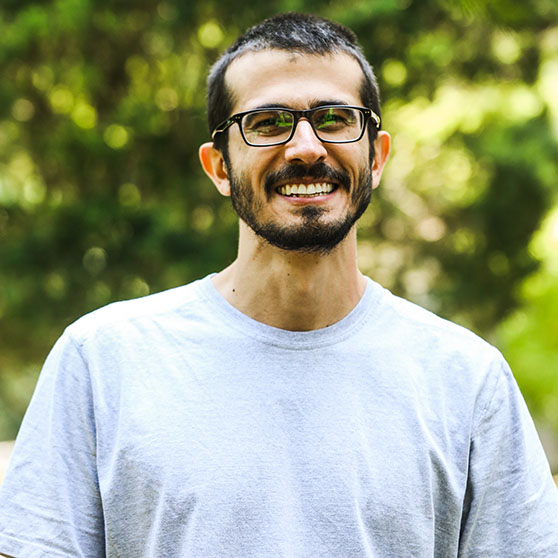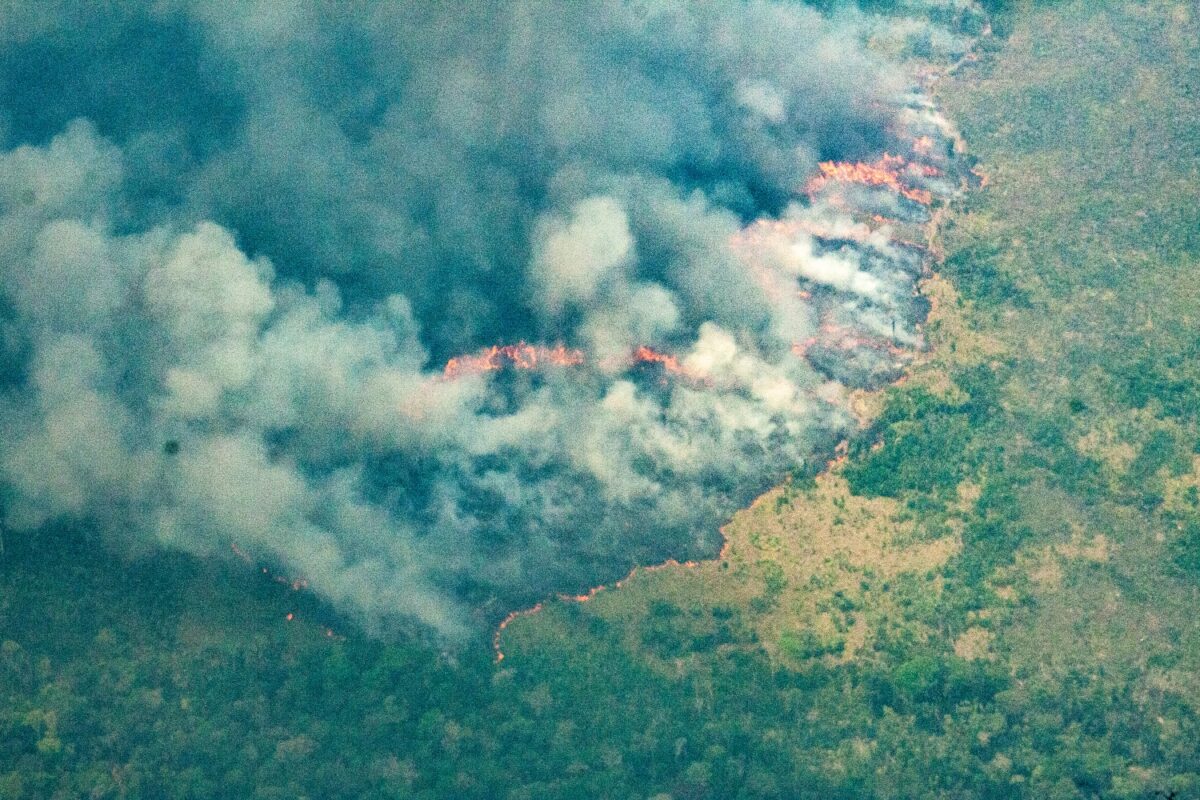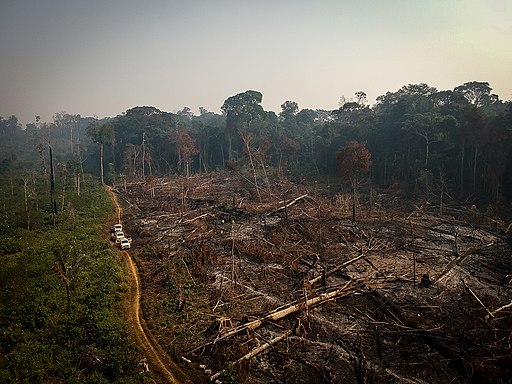In addition to deforestation, forest degradation provoked by human action is among the main sources of carbon emission. Fire and drought are the main factors responsible for future degradation, indicative of the gravity of climate change. Even if the Amazonian countries achieve the promised goal of zero deforestation in 2030, the degradation will continue, as David Lapola explains in an interview with InfoAmazonia.
While deforestation is widely studied, the processes of forest degradation are advancing silently, causing impacts that are just as grave, if not more so. “We’ve had our sights on the fish and we forgot to look at the cat. You have to keep an eye on the two things that are happening at the same time,” warns David Lapola of the Center of Meteorological and Climate Studies Applied to Agriculture (Cepagri) at the State University of Campinas (Unicamp), lead author of the study that was featured on the cover of Science last January, revealing that 38% of the standing forest has suffered some kind of degradation.
Developed by a group of 35 scientists, the study differentiates deforestation, which implies a change in the use of the soil – for instance in the conversion of the forest into farmland or pasture – from degradation, a process in which an area is still forested but gradually losing vegetation and without the same environmental services of an intact forest.
Based on an analysis of data published between 2001 and 2018, the study delves into the causes and effects of forest disturbance throughout the entire Amazon region and shows the impacts of the four main drivers of degradation: fire, selective logging, drought and edge effects – alterations in the forest caused by deforested surrounding areas.
Ecologist David Lapola, who likes to unwind by cultivating a garden in the back yard of his home in the city of Campinas or exploring the region on bicycle, holds a master’s degree in meteorology from INPE, a PhD in earth system modeling from the Max Planck Institute in Alemanha and coordinates the Earth System Science Laboratory (LabTerra) at Unicamp, which researches the relationship between man and nature in Brazil in the face of global climate change.
In an interview with InfoAmazonia, Lapola said that regardless of the trajectory of deforestation in the Amazonian countries, if the world continues emitting greenhouse gases at the current rate, by 2050, fires and extreme droughts could degrade up to 70% of the forest that remains.
InfoAmazonia – What do you consider most revealing or surprising about the study’s results?
David Lapola – The extent of what we are considering in the study as degradation in the Amazon, affecting 38% of all the remaining forests. The carbon emitted by this degradation in the períod analyzed, which was from 2001 to 2018, is the equivalent of, if not greater than, the carbon emitted by deforestation in the same period.

The carbon emitted by this degradation in the períod analyzed, which was from 2001 to 2018, is the equivalent of, if not greater than, the carbon emitted by deforestation in the same period.
David Lapola
So degradation can generate effects that are just as grave as deforestation?
Definitely. Even if Brazil and the other Amazonian countries do all their homework right now to stop deforestation and we continue having greenhouse gas emissions in the rest of the world, these droughts can effect the region and degrade the forest the same way. Of course, stopping the burning, the selective logging and the deforestation itself is the responsibility of Brazil and the other Amazonian countries. But stopping the global climate change that brings these droughts and this degradation through drought is not Brazil’s responsibility alone. It’s a global responsibility for the forest.
According to the study, the Amazon’s species have little or no evolutionary adaptation to fire. Does this raise the significance of extreme drought and fires in the Amazonian biome?
Absolutely. Fire is not a natural element of the Amazonian biome. There are studies showing that natural fire in the Amazon has a reincidence rate of around 500 years. In other words, it is non-existent in our scale of time. So all the burning is provoked by people. In the Cerrado, this rate of natural fires takes place every five, six or ten years, but it’s a different dynamic, it’s a different biome, a different climate even, where you have a greater incidence of lightning strikes, more production of dry biomass. There, the plants are adapted to this. The grasses burn and are reborn more vigorous than before. And the trees of the Cerrado have that thick bark, a cork precisely to resist fire, something that we don’t have in the Amazon. You can find a little of this there in the transition area between the Cerrado and the Amazon, but venturing inside (the forest) there’s nothing like this. All the trees’ bark there is very thin, so fire is cruel, extremely cruel, to the forest. If you have an incidence of three fires in three straight years, for example, you have a loss of as much as 80% of the forest’s biomass.
Fire is not a natural element of the Amazonian biome. There are studies showing that natural fire in the Amazon has a reincidence rate of around 500 years. In other words, it is non-existent in our scale of time. So all the burning is provoked by people.
David Lapola
What are the main problems caused by edge effects?
Let us imagine a tree of a certain species that is there in the middle of the forest with that humid climate, with lots of trees around it that also protect it to a certain extent, generating all that humidity and whatnot. Suddenly, there is deforestation nearby and this tree of ours that was once protected in the fully forested environment now finds itself in close proximity to a pasture, for example. These first 100 or 200 meters of the forest, which now border an area that is no longer forest, will have much more incidence of light, higher temperatures, more wind blowing in. And this tree of ours from the example is not adapted to this, so it can take just three, five or ten years for it to eventually die, a much shorter life than if it had remained in the middle of the forest. This ends up favoring species that are more adapted to this environment, a lot of vines moving in and, over time, it ends up decreasing the biomass, not to mention the diversity of species, in this border area. The microclimate is also modified.
How do these 4 main disturbances that cause degradation along with deforestation harm the forest?
According to the “back-of-the-envelope” calculation (i.e. approximate calculation), 38% of the forest has been degraded plus around 17% of the biome has been deforested. This makes 55% of the Amazon modified by humans in some way. One very evident manner is deforestation, which has been thoroughly researched since the late 1980s, with lots of studies, causes, impacts, changes in climate, economic changes. Now, the question of the degraded 38%: What is this forest? The quality of this forest is no longer the same, It’s disturbed.
Then comes the question of the Amazon’s tipping point. I think that all this contributes to the destabilization of the Amazonian system and ends up reverberating in the local population and neighboring regions in terms of providing ecosystem services. The problem is that this 38% of degraded forest is much less studied, much less known than deforestation. You have to keep an eye on both things that are happening at the same time.
The problem is that this 38% of degraded forest is much less studied, much less known than deforestation.
David Lapola
What is your group’s forecast for the forest by the year 2050?
This was a novelty that the article introduced. It is the first attempt to project degradation. There have been several studies doing the same thing for deforestation for a long time, but not for degradation. One interesting finding is that, even in an optimistic scenario, in which deforestation halts by 2030, which is Brazil’s promise to the Climate Convention, degradation could continue to reach 51% of the remaining forest and we would go from 38% to 51%. In a pessimistic scenario, we would reach 70%.
Now this 70% would be of a much smaller area of forest according to the pessimistic scenario because deforestation would not stop and would follow the upward trend, so there would be less forest left. But, of this smaller forest, there would be an even larger percentage that would be degraded.
Even in an optimistic scenario, in which deforestation halts by 2030, which is Brazil’s promise to the Climate Convention, degradation could continue to reach 51% of the remaining forest and we would go from 38% to 51%. In a pessimistic scenario, we would reach 70%.
David Lapola
And a lot of that from the future falls on climate change because in our initial modeling, the main factors are fire and drought. Both are closely related to the climate issue. They are the two main factors responsible for this future degradation.
The study mentions that the loss of ecosystem services as a result of extreme climate change in the Amazon could lead to regional economic losses of $7.7 trillion over a 30-year period. Can you comment on that?
That was an analysis to try to understand what kind of economic impact would come from the Amazon passing the “tipping point,” turning into a savanna. And we didn’t even venture outside the Amazon to talk about the exportation of moisture to other regions, for example. It’s only inside the Amazon: the impact on agriculture, fishing, systems of transportation which, in the region, depend heavily on the rivers. This vicious cycle of the forest becoming degraded due to the climate, thus exporting less moisture to the region’s atmosphere and generating less rainfall on itself affects the level of the rivers. There is the issue of health-related harms when we have more fires. It has been numerically proven that this significantly increases hospitalizations and thus represents higher costs. So, agriculture, fishing, the transportation system, the health care system, energy production.
There are many socioeconomic sectors. We tried to collect evidence from the literature or previous incidences of severe droughts in the region and how this affected the socioeconomics of the Amazon and tried to scale this up over a longer period of time.
What are the main impacts that forest degradation has on the peoples of the forest?
There are few people who finance and effectively execute this degradation. Few people benefit and end up profiting from it, but this degradation creates a burden for many people, including me and you, because the emissions there in the Amazon end up affecting our lives in a certain way with global climate change.
Few people benefit and end up profiting from it, but this degradation creates a burden for many people.
David Lapola
So it is undeniable that people who depend more directly on the forest, which are the riverside communities, the caboclos, the indigenous, end up being more affected. If you think about the context of the exploitation of sustainable harvesting for their own sustenance or for the commercialization of the forest products that they harvest, which ends up helping with their food security, degradation is going to eventually affect supply, the availability of these products, whether it be fruit or wood or even hunting. All four forms of disturbance end up affecting the presence of animals.
The bottom line is that it affects everyone. But, as I mentioned, it is most concerning for these traditional populations. The indigenous people, the riverside people and caboclos account for around 17% of the Amazon’s population, but they are very vulnerable because they depend more heavily on the forest and have less access to services of assistance. This is precisely what is happening there in the Yanomami Territory.
Which of the four factors cited in the study is most significant in the Legal Amazon? Are there hotspots for each one?
Look, since Brazil accounts for 60% of the Amazon, it was pretty obvious that, in absolute terms, most of this degradation would be here on our shoulders, right? And that’s exactly it.

The fires and the edge effects end up following the pattern of deforestation, so this hotspot you asked about would be the Arc of Deforestation (the southern and eastern edges of the forest). Selective logging, however, is already far from the deforestation frontier. It’s deeper inside the forest, in Rondônia, Mato Grosso and Pará mainly. And, surprisingly, the drought hotspots are more concentrated in the central and western Amazon which is a pretty different pattern of fire and border.
Considering the four main drivers of forest degradation, drought affects 41.1% of the Amazon’s remaining forest cover. Is it the most difficult factor of degradation to combat?
Without a doubt. We’ve been trying to solve the problem of global climate change for 30 years. We haven’t gotten very far up to this point and, at the same time, I don’t think anyone is crazy enough to start employing resources to irrigate the Amazon in the event of a drought to avoid impacts on the forest.
What measures can help contain the degradation of the Amazon?
One example of the scientific side that could help in terms of concrete action is to develop an operational monitoring system like what we have for deforestation, except it would have to be a little more elaborate because deforestation is easier to observe. There is a technology known as LiDAR (Light Detection And Ranging) which is a satellite sensor. It scans the surface with a laser and can see the 3D structure of the forest, not just the canopies, as optical imaging does. So if, from one year to the next, you remove one tree, or two or three, it would theoretically be able to detect it, but this is not yet operational. It’s still in the testing phase.
We cite simpler things such as the concept of “smart forests,” like, for instance, a pilot project in Pará in areas where there are a lot of invasions in indigenous territories by land grabbers and loggers. They take used cell phones and place them in strategic areas of the forest and these phones have an app that listens to the ambient sound. If there is sound from a chainsaw, an axe, wood being cut, machinery, then it issues a warning either to the indigenous community or authorities to go there right away. It’s a variation on the concept of “smart cities,” where you have lots of sensors, each one interconnected to the other and the internet, to monitor and improve the functioning of the urban ecosystem. It is already widely used by the forestry sector mainly outside of Brazil to optimize harvests. So this is another purpose, but it could be used in native forests for the purpose of conservation.
Report by InfoAmazonia for the project PlenaMata.





